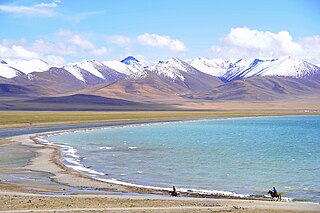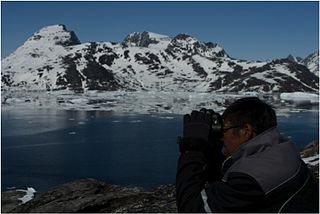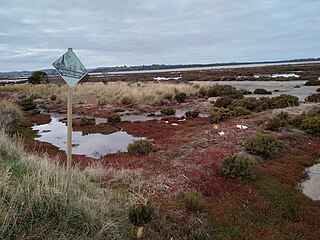
Ecotourism is a form of tourism marketed as "responsible" travel to natural areas, conserving the environment, and improving the well-being of the local people. The stated purpose may be to educate the traveler, to provide funds for ecological conservation, to directly benefit the economic development and political empowerment of local communities, or to foster respect for different cultures and human rights.

Habitat conservation is a management practice that seeks to conserve, protect and restore habitats and prevent species extinction, fragmentation or reduction in range. It is a priority of many groups that cannot be easily characterized in terms of any one ideology.

Environmental protection is the practice of protecting the natural environment by individuals, groups and governments. Its objectives are to conserve natural resources and the existing natural environment and, where it is possible, to repair damage and reverse trends.

Environmental resource management is the management of the interaction and impact of human societies on the environment. It is not, as the phrase might suggest, the management of the environment itself. Environmental resources management aims to ensure that ecosystem services are protected and maintained for future human generations, and also maintain ecosystem integrity through considering ethical, economic, and scientific (ecological) variables. Environmental resource management tries to identify factors affected by conflicts that rise between meeting needs and protecting resources. It is thus linked to environmental protection, sustainability, integrated landscape management, natural resource management, fisheries management, forest management, and wildlife management, and others.

Natural resource management (NRM) is the management of natural resources such as land, water, soil, plants and animals, with a particular focus on how management affects the quality of life for both present and future generations (stewardship).

DPSIR is a causal framework used to describe the interactions between society and the environment. It seeks to analyze and assess environmental problems by bringing together various scientific disciplines, environmental managers, and stakeholders, and solve them by incorporating sustainable development. First, the indicators are categorized into "drivers" which put "pressures" in the "state" of the system, which in turn results in certain "impacts" that will lead to various "responses" to maintain or recover the system under consideration. It is followed by the organization of available data, and suggestion of procedures to collect missing data for future analysis. Since its formulation in the late 1990s, it has been widely adopted by international organizations for ecosystem-based study in various fields like biodiversity, soil erosion, and groundwater depletion and contamination. In recent times, the framework has been used in combination with other analytical methods and models, to compensate for its shortcomings. It is employed to evaluate environmental changes in ecosystems, identify the social and economic pressures on a system, predict potential challenges and improve management practices. The flexibility and general applicability of the framework make it a resilient tool that can be applied in social, economic, and institutional domains as well.

The Trans himalaya, or "Gangdise – Nyenchen Tanglha range", is a 1,600-kilometre-long (990 mi) mountain range in China, India and Nepal, extending in a west–east direction parallel to the main Himalayan range. Located north of Yarlung Tsangpo river on the southern edge of the Tibetan Plateau, the Transhimalaya is composed of the Gangdise range to the west and the Nyenchen Tanglha range to the east.

Community forestry is an evolving branch of forestry whereby the local community plays a significant role in forest management and land use decision making by themselves in the facilitating support of government as well as change agents. It involves the participation and collaboration of various stakeholders including community, government and non-governmental organisations (NGOs). The level of involvement of each of these groups is dependent on the specific community forest project, the management system in use and the region. It gained prominence in the mid-1970s and examples of community forestry can now be seen in many countries including Nepal, Indonesia, Korea, Brazil, India and North America.

Ecosystem management is an approach to natural resource management that aims to ensure the long-term sustainability and persistence of an ecosystem's function and services while meeting socioeconomic, political, and cultural needs. Although indigenous communities have employed sustainable ecosystem management approaches implicitly for millennia, ecosystem management emerged explicitly as a formal concept in the 1990s from a growing appreciation of the complexity of ecosystems and of humans' reliance and influence on natural systems.
Community-based monitoring (CBM) is a form of public oversight, ideally driven by local information needs and community values, to increase the accountability and quality of social services such as health, development aid, or to contribute to the management of natural resources. Within the CBM framework, members of a community affected by a social program or environmental change track this change and its local impacts, and generate demands, suggestions, critiques and data that they then act on, including by feeding back to the organization implementing the program or managing the environmental change. For a Toolkit on Community-Based Monitoring methodology with a focus on community oversight of infrastructure projects, see www.communitymonitoring.org. For a library of resources relating to community-based monitoring of tropical forests, see forestcompass.org/how/resources.
Catch share is a fishery management system that allocates a secure privilege to harvest a specific area or percentage of a fishery's total catch to individuals, communities, or associations. Examples of catch shares are individual transferable quota (ITQs), individual fishing quota (IFQs), territorial use rights for fishing (TURFs), limited access privileges (LAPs), sectors, and dedicated access privileges (DAPs).
The biocapacity or biological capacity of an ecosystem is an estimate of its production of certain biological materials such as natural resources, and its absorption and filtering of other materials such as carbon dioxide from the atmosphere.
Population, health, and the environment (PHE) is an approach to human development that integrates family planning and health with conservation efforts to seek synergistic successes for greater conservation and human welfare outcomes than single sector approaches. There is a deep relationship between population, health and environment. Those subjects are not only related to each other but also to other important aspects that are very necessary for keeping PHE in a close-knit relationship.
Environmental stewardship refers to the responsible use and protection of the natural environment through active participation in conservation efforts and sustainable practices by individuals, small groups, nonprofit organizations, federal agencies, and other collective networks. Aldo Leopold (1887–1949) championed environmental stewardship in land ethics, exploring the ethical implications of "dealing with man's relation to land and to the animals and plants which grow upon it."
The Communal Areas Management Programme for Indigenous Resources (CAMPFIRE) is a Zimbabwean community-based natural resource management program. It is one of the first programs to consider wildlife as renewable natural resources, while addressing the allocation of its ownership to indigenous peoples in and around conservation protected areas.
Co-management, also known as community-based management, community-based resource management, cooperative management, joint management, and collaborative management, in the broadest terms refers to the administration of a particular place or resource being shared between multiple local and state management systems. Although co-management encompasses a spectrum of power-sharing arrangements, in the Canadian context it typically refers to agreements between government agencies and representatives of Indigenous peoples in Canada to jointly make land use and resource management decisions about a tract of government-controlled land or resource (e.g.fishery.).

Participatory monitoring is the regular collection of measurements or other kinds of data (monitoring), usually of natural resources and biodiversity, undertaken by local residents of the monitored area, who rely on local natural resources and thus have more local knowledge of those resources. Those involved usually live in communities with considerable social cohesion, where they regularly cooperate on shared projects.
Paige Fischer is an environmental scientist from the Pacific Northwest whose research focuses mainly on the human dimensions of environmental changes. She is especially interested in forest ecology and conservation. She is currently an assistant professor at the University of Michigan's School for Environment and Sustainability, teaching upper level classes about analysis methods and social vulnerability to climate change.
Hponkanrazi Wildlife Sanctuary is a protected area in northern Myanmar, stretching over an area of 2,703.95 km2 (1,044.00 sq mi). It was established in 2003. It encompasses riverine habitats, subtropical moist forest, temperate forest, deciduous forest and alpine forest. It is contiguous with Hkakaborazi National Park, Bumhpa Bum Wildlife Sanctuary and Hukaung Valley Wildlife Sanctuary. Together, they form a 30,269 km2 (11,687 sq mi) large protected area complex of natural forest called the Northern Forest Complex. It is managed by the Forest Department.

In 2010, Australia formulated a strategy for conserving land under the National Reserve System, which would be "a national network of public, Indigenous and private protected areas over land and inland water". States, territories and the commonwealth have enacted legislation to create and protect private lands "in perpetuity". Additionally, they have created mechanisms to fund the conservation of biodiversity in the shorter term. See for example, The Two Rivers Catchment Reserve.











